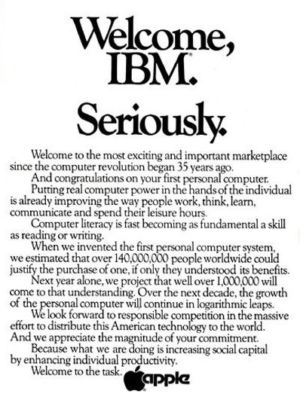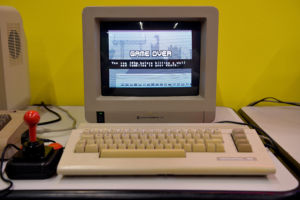-
The original IBM PC 5150, with a printer, introduced in August 1981. This wasn't really the first IBM personal computer, however... (read part one of the story to find out more).SSPL/Getty Images
-
The original IBM PC model 5150.
-
An original IBM PC 5150 print ad. Ads were different back then...
August 12, 1981

Kildall, who remained convinced until his death that MS-DOS was a rip-off of CP/M and from time to time claimed to be able to prove it via this secretly embedded message or that odd API attribute, believed that IBM deliberately priced CP/M six times higher than MS-DOS in order to make sure no one actually bought it, thus honoring the letter of their agreement but not the spirit. IBM, for its part, simply claimed that Digital had demanded such high licensing fees that they had no choice. Of the four operating paradigms, three of them—CP/M, Microsoft BASIC, and UCSD Pascal—ended up being used so seldom that few today even remember they were options in the first place. MS-DOS, of course, went on to conquer the world.
The hardware, meanwhile, is best described as stolid and, well, kind of boring. For all of its unusual (by IBM standards) development process, the final product really wasn't far removed from what people had come to expect from IBM. There was no great creative flair about its design, but, from its keyboard that clunked satisfyingly every time you pressed a key to its big, substantial-looking case with lots of metal inside, it looked and operated like a tool you could rely on. And that wasn't just a surface impression. Whatever else you could say about it, the IBM PC was built to last. Perhaps its most overlooked innovation is its use of memory with an extra parity bit to automatically detect failures. It was the first mass-market microcomputer to be so equipped, giving protection from rare but notoriously difficult to trace memory errors that could cause all sorts of unpredictable behaviour on other early PCs. RAM parity isn't really the sort of thing that inflames the passions of hackers, but for a businessperson looking for a machine to entrust with her livelihood, it's exactly the sort of thing that made IBM IBM. They made you feel safe.
Even if its lack of design imagination would just confirm hackers' prejudices, for plenty of businesspeople uncertain about all these scruffy upstart companies the IBM PC's arrival legitimised the microcomputer as a serious tool for a serious purpose. Middle managers rushed to buy them, because no one ever got fired for buying an IBM—even if no one was ever all that excited about buying one either. IBM sold some 13,500 PCs in the last couple of months of 1981 alone, and the numbers just soared from there.

With IBM in the PC game at last—machines actually started shipping ahead of schedule in October—those who had been there all along were left to wonder what it all meant. Radio Shack's John Roach had the most unfortunate response: "I don't think it's that significant." Another Radio Shack executive was only slightly less dismissive: "There definitely is a new kid on the block, but there is nothing that IBM has presented that would blow the industry away."
Apple, then as now much better at this public-relations stuff than just about anyone else, took a full-page advertisement in the Wall Street Journal saying, "Welcome IBM. Seriously." Like so much Apple advertising, it was a masterful piece of rhetoric, managing to sound gracious while at the same time making it clear that a) IBM is the latecomer and b) Apple intend to treat them as peers, nothing more.
-
The original IBM PC 5150 would be so successful that it would go on to spawn many different variations over the next few years.Mark Madeo/Future Publishing via Getty Images
-
Starting with the IBM PC XT in 1983, which had a built-in hard drive.Mark Madeo/Future Publishing via Getty Images
-
Then the IBM PC AT in 1984, which had a newer 80286 CPU.Mark Madeo/Future Publishing via Getty Images
-
The IBM PCjr, officially the company's first attempt to break into the home computing market, came out in 1984.Mark Madeo/Future Publishing via Getty Images
Epilogue
Years later it would be clear that the arrival of the IBM PC was the third great milestone in PC history, following the first microcomputer kits in 1975 and the Trinity (Apple II, PET, TRS-80) of 1977. It also marked the end of the first era of Microsoft's history, as a scrappy but respected purveyor of BASICs, other programming languages, and applications software (in that order). In the wake of the IBM PC's launch, Microsoft quite quickly cut their ties to the older, more hacker-ish communities in which they had grown up to hitch their wagon firmly to the IBM and MS-DOS business-computing train. Plenty of aesthetic, technical, and legal ugliness waited for them down those tracks, but so did hundreds and hundreds of billions of dollars.
The other players in this little history had more mixed fates. Seattle Computer Products straggled on for a few more years, but finally went under in 1985. Rod Brock did, however, still have one thing of immense value. You'll remember that Brock sold 86-DOS to Microsoft outright, but had received an exclusive license to it in return. With his company failing, he decided to cash out by selling that license on the open market to the highest bidder. Microsoft, faced with seeing a huge vendor like Radio Shack, Compaq, or even IBM themselves suddenly able to sell MS-DOS-equipped machines without paying Microsoft anything, decided retroactively that the license was nontransferable. The whole thing devolved into a complicated legal battle, one of the first of many for Microsoft. In the end Brock did not sell his license, but he did receive a settlement cheque for $925,000 to walk away and leave well enough alone.
Of course, the man history has immortalised as the really big loser in all this is Gary Kildall. That, however, is very much a matter of degree and interpretation. Digital Research lost its position at the head of business computing, but continued for years as a viable and intermittently profitable vendor of software and niche operating systems. Kildall also became a household name to at least the nerdier end of the television demographic as the mild-mannered, slightly rumpled co-host of PBS' Computer Chronicles series. Novell finally bought Digital in 1991, allowing Kildall to retire a millionaire. For a loser, he did pretty well for himself in the end. Kildall, always more interested in technology than in business, was never cut out to be Bill Gates anyway. Gates may have won, but perhaps Kildall had more fun.

So, while the business community flocked to the IBM and MS-DOS in remarkably short order, the world of home, hobbyist, and educational computing would remain fairly divorced from that of the IBM PC for years to come. Eventually, of course, MS-DOS would win out—but that would take more than a decade instead of mere months, allowing space for some of the most vibrant and fun computing cultures to grow and thrive.
* * *
Jimmy Maher is the author of The Digital Antiquarian, an ongoing history of interactive entertainment and matters related in blog form. This article, about the history of the IBM PC, originally appeared there. If you enjoyed this article and the many others on his personal site, you can support his ongoing work by becoming his Patreon patron.
reader comments
127